Why AM/FM Radio And Quick Service Restaurants Are Made For Each Other
Click here to view a 15-minute video of the key findings.
Click here to download a PDF of the slides.
Key takeaways:
- Frequent fast-food consumers are younger, are more likely to be employed, more likely to have kids, and clock a lot of miles in their vehicles
- Heavy AM/FM radio listeners are frequent fast-food diners: Most AM/FM radio ad impressions are generated by heavy QSR category users
- Heavy TV viewers under index on QSR; Most TV impressions are generated by light QSR category users
- There is a mismatch in fast-food advertising media budgets: TV is overused and AM/FM radio is underutilized
- QSR TV deliveries are collapsing: AM/FM radio to the rescue; AM/FM radio makes QSR TV campaigns better by generating significant incremental reach, especially in younger demos
- ABX creative testing: QSR AM/FM radio ads test at 89% of the effectiveness of TV at one-fourth the CPM
- Nielsen sales lift studies reveal AM/FM radio ads generate a +6% increase in total QSR buyers and a $3 to $1 return on investment
Frequent fast-food consumers are younger, are more likely to be employed, and have kids
Nielsen Scarborough reports that compared to the average person, frequent quick service restaurants (QSR) consumers are younger than the average U.S. adult with a median age of 42 versus the average of 50. Frequent QSR customers are more likely to have kids and be employed.
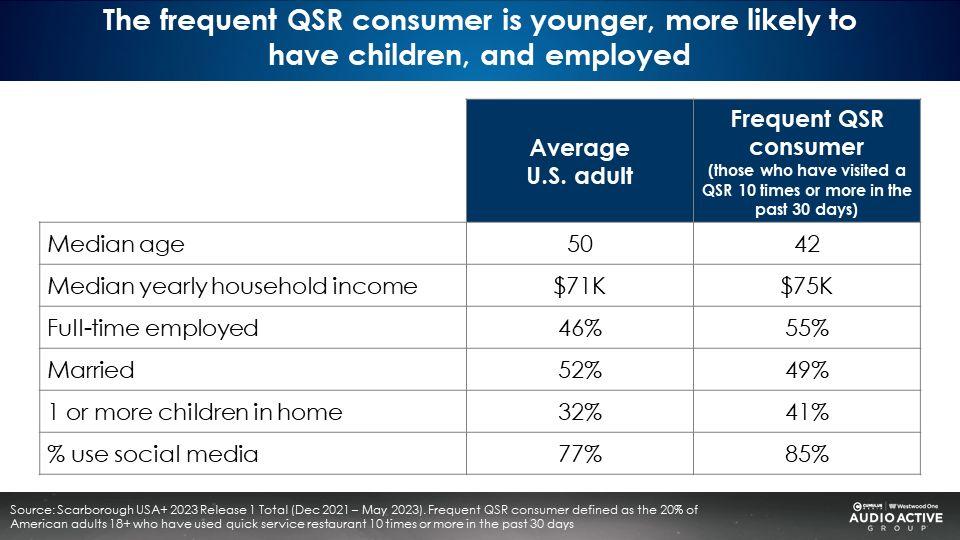
Since frequent fast-food diners are more likely to work and have kids, it is no surprise that they clock a lot of miles in their vehicles
More miles traveled translates into greater QSR dining occasions. The 2023 Nielsen Scarborough study reports that consumers who visit quick service restaurants 10+ times in the past month are high mileage drivers.
Those who clock more miles in the car are much more likely to be frequent fast-food diners. If a consumer travels more than 100+ miles per week in a vehicle, they are more likely to dine often at quick service restaurants.
The blue line below represents the U.S. average of 20% who dine 10+ times a month at a QSR. 28% of those who have driven 250 to 499 miles in the last week are 10+ QSR visitors, +40% more than the U.S. average.
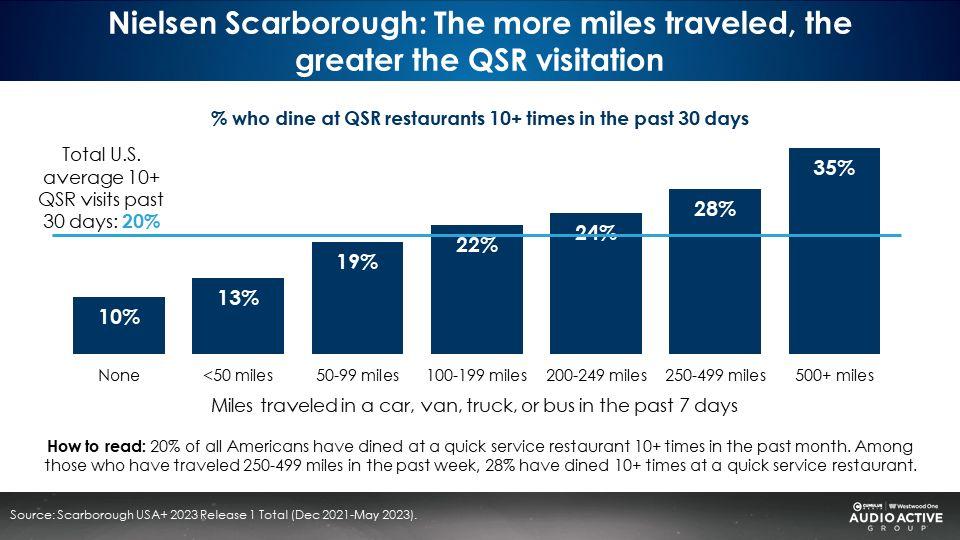
Heavy TV viewers are infrequent fast-food diners: Most TV ad impressions are generated by light QSR category users
The more TV people watch, the fewer the fast-food dining occasions. Nielsen Scarborough indexed 10+ monthly QSR visits against five equal groups of TV viewers, organized from the lightest viewers to the heaviest viewers.
The data reveals that the heaviest TV viewers are 15% less likely to be frequent QSR visitors. The lightest TV viewers, those who are virtually impossible to reach with TV ads, are more likely to be frequent fast-food diners.
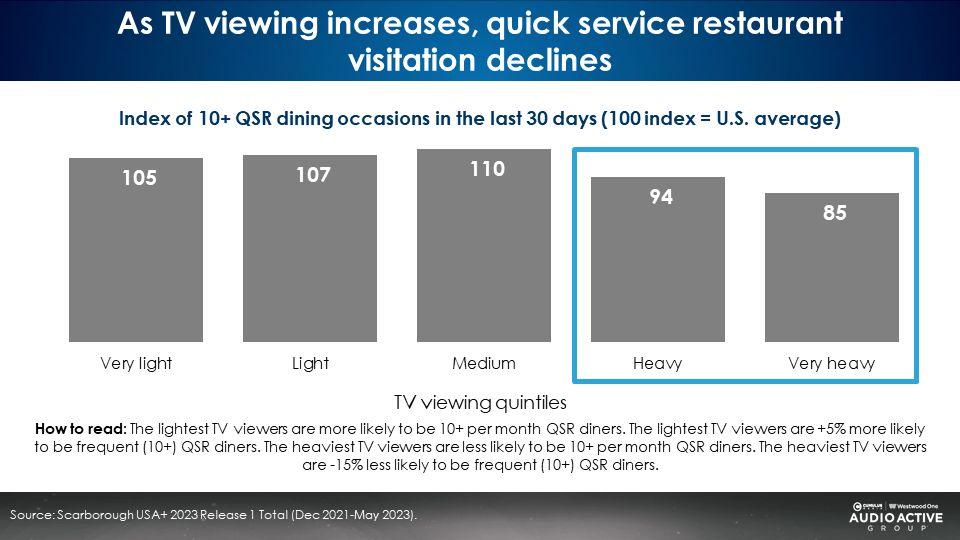
Heavy AM/FM radio listeners are frequent fast-food diners: Most AM/FM radio ad impressions are generated by heavy QSR category users
AM/FM radio’s best customers are the fast-food sector’s most frequent diners. Nielsen Scarborough indexed 10+ monthly QSR visits against the five equally sized groups of AM/FM radio listeners, from the lightest listeners to the heaviest listeners.
Heavy AM/FM radio listeners are much more likely to be frequent QSR visitors. The heaviest U.S. AM/FM radio listeners are +23% more likely to be 10+ per month fast-food diners.
There is a direct relationship between AM/FM radio listening and fast-food dining occasions. The more you listen, the more QSR you consume.
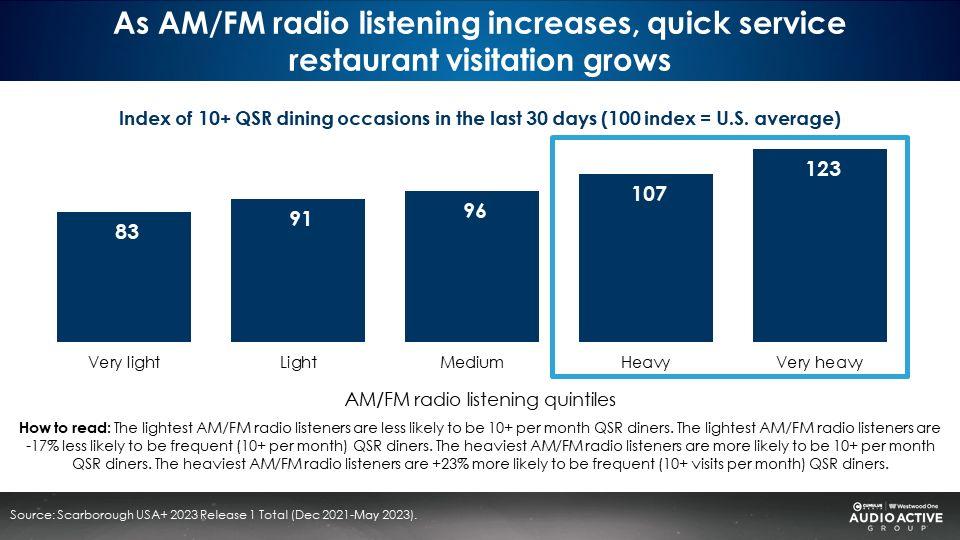
To QSR brands, AM/FM radio impressions are worth +45% more than TV impressions
Most ad impressions are generated by the heaviest users of a medium. There is a “20%/50%” rule. The 20% heaviest media users generate most (~50%) of the ad impressions. The QSR category usage habits of the top 20% heavy media users are crucial for media planners.
America’s heavy TV viewers (the top 20% of viewers who watch the most) under-index (85) for 10+ monthly QSR trips. Heavy TV viewers are -15% less likely than the U.S. average to be frequent fast-food diners.
Conversely, America’s heavy AM/FM radio listeners (the top 20% who listen the most) over-index (123) for 10+ monthly QSR trips. Heavy AM/FM radio listeners are +23% more likely than the U.S. average to be frequent fast-food diners.
A head-to-head comparison of QSR dining occasions between heavy TV viewers and heavy AM/FM radio listeners reveals a massive advantage for AM/FM radio. A QSR campaign on AM/FM radio is +45% more likely than TV (123 vs. 85) to reach frequent fast-food diners.
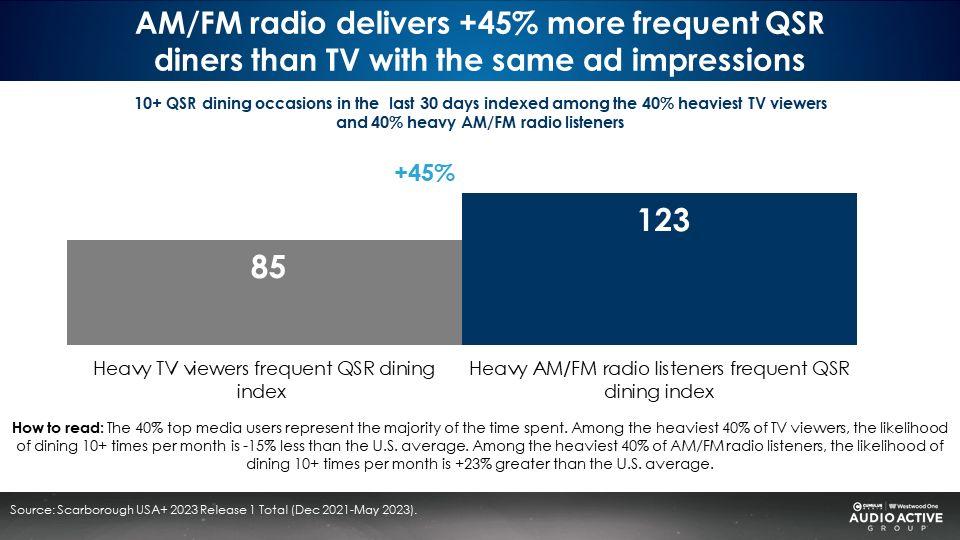
The profile of the frequent fast-food diner is most similar to Internet users, heavy AM/FM radio listeners, and podcast listeners
Compared to frequent fast-food customers, heavy TV viewers are much older, less employed, and much less likely to have kids.
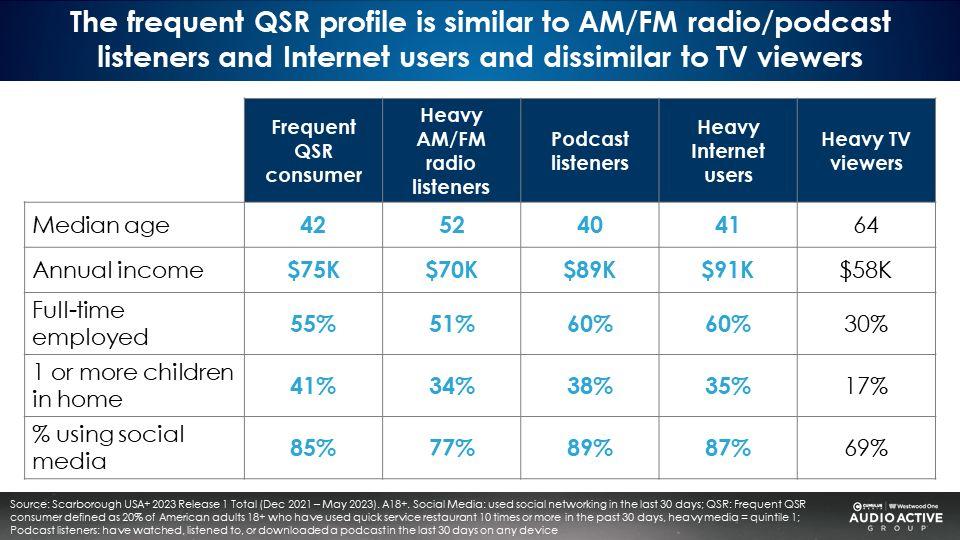
There is a mismatch in fast-food advertising media budgets: TV is overused and AM/FM radio is underutilized
MRI Simmons reports 6AM-7PM is “fast-food prime time” when Americans spend more time with AM/FM radio than TV. Among frequent fast-food customers, 50% of 6AM-7PM media usage goes to AM/FM radio and 50% goes to TV. Yet, between the two media, 92% of the ad dollars goes to TV and only 8% goes to AM/FM radio, according to Vivvix. A major mismatch.
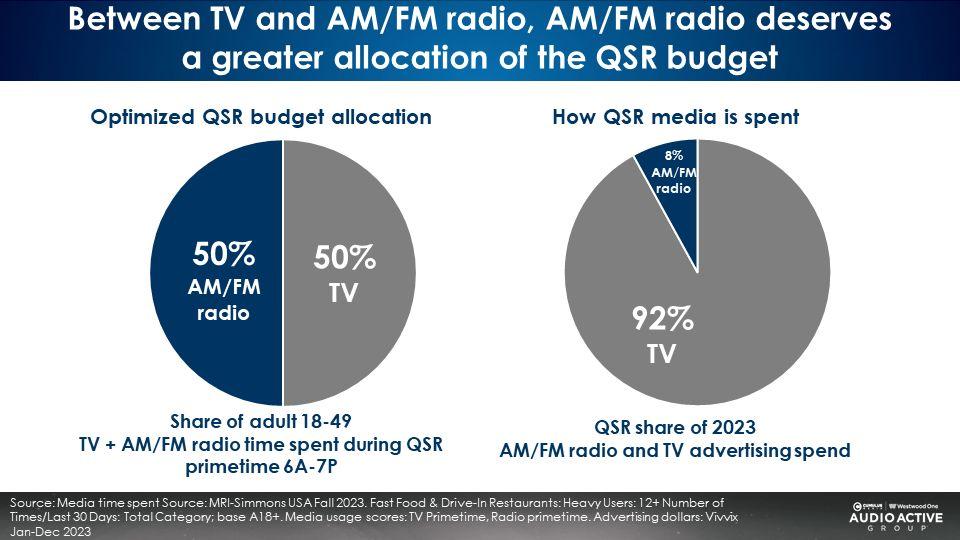
QSR linear TV reach delivery plummets
Nielsen Media Impact is one of Nielsen’s optimization and media planning platforms. An NMI analysis examined monthly linear TV reach delivery for six QSR brands.
Monthly reach from one month in 2020/2021 was compared to May 2023. On average, the average QSR brand saw their linear TV reach drop by -34%.
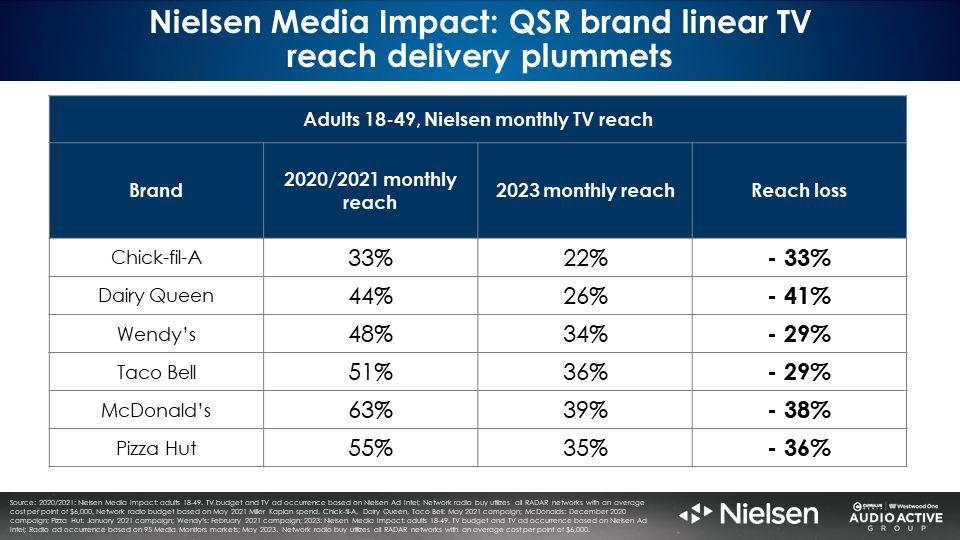
AM/FM radio to the rescue: AM/FM radio makes QSR TV campaigns better by generating significant incremental reach
Nielsen Media Impact reveals QSR TV campaigns experience a massive lift in 18-49 reach with the overlay of AM/FM radio campaigns. On average, AM/FM radio generated a massive +65% increase in 18-49 incremental monthly reach for six QSR brands.
Nielsen examined the as-run TV and AM/FM radio campaigns from May 2023. NMI determined the incremental lift generated by AM/FM radio among persons 18-49.
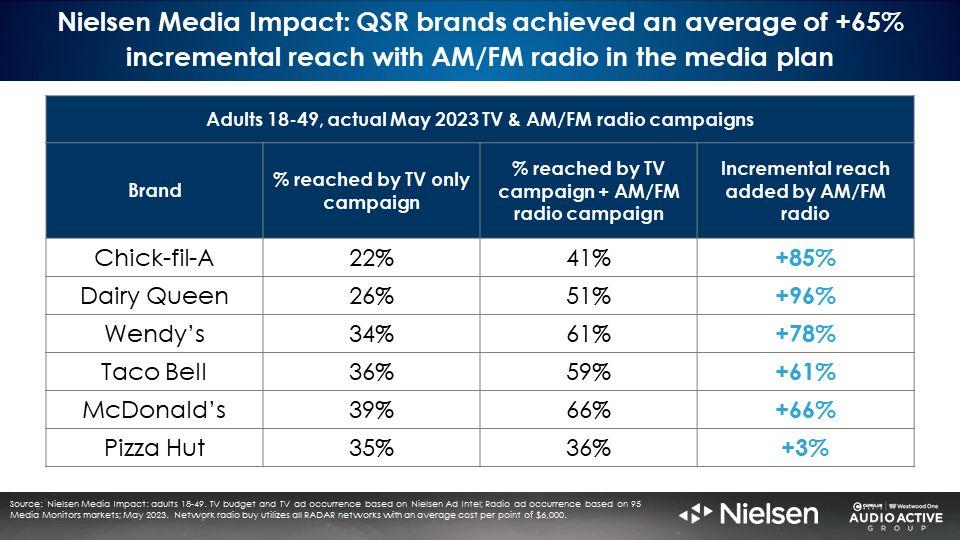
The May 2023 linear TV campaign for Wendy’s reached 34% of all U.S. 18-49 adults in a month. The AM/FM radio campaign run by Wendy’s lifted reach by an astonishing +78% to a 61% monthly reach.
How AM/FM radio makes QSR TV better: Massive reach increases in younger demos
AM/FM radio has a +40% reach advantage over TV among 18-49s. According to Nielsen’s Q3 2023 Comparable Metrics, American linear television reaches only 58% of the 18-49 demographic in a typical week. Nielsen reveals AM/FM radio weekly reach among adults 18-49 is 81%.
Among adults 18-34, Nielsen reports TV’s weekly reach is only 50% to AM/FM radio’s 77%. In a typical week in America, AM/FM radio reaches +54% more adults 18-34 than TV.
Given AM/FM radio’s significant 18-49 reach advantage over TV, it is not surprising to find adding AM/FM radio to the media plan generates a massive lift in incremental reach to QSR TV campaigns.
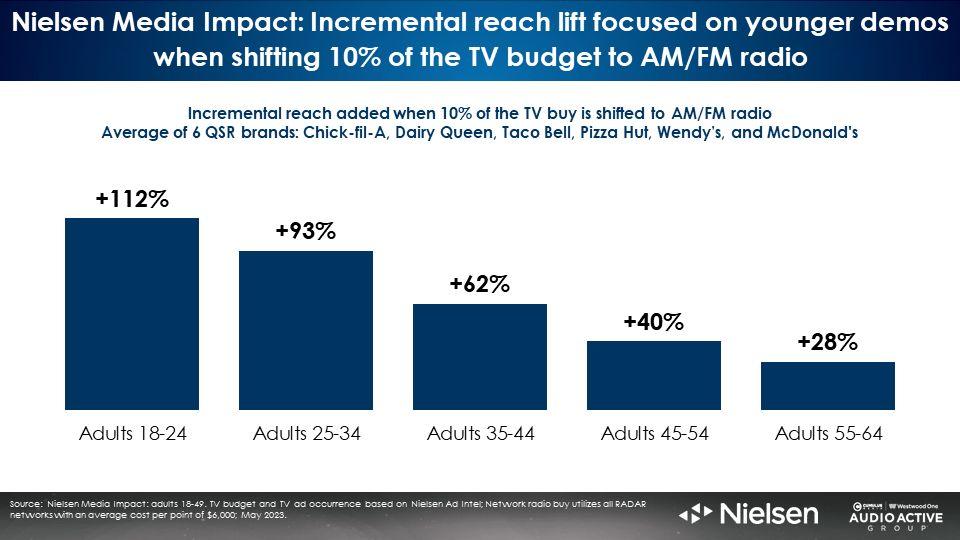
Assuming 10% of QSR budgets are allocated to AM/FM radio, across the six brands studied, AM/FM radio would generate a:
- +62% increase in 35-44 reach
- +93% growth in 25-34 reach
- +112% uplift in 18-24 reach
The younger the demographic, the greater the lift incremental reach generated by AM/FM radio.
A wide diversity of podcast genres and AM/FM radio programming formats deliver frequent QSR consumers
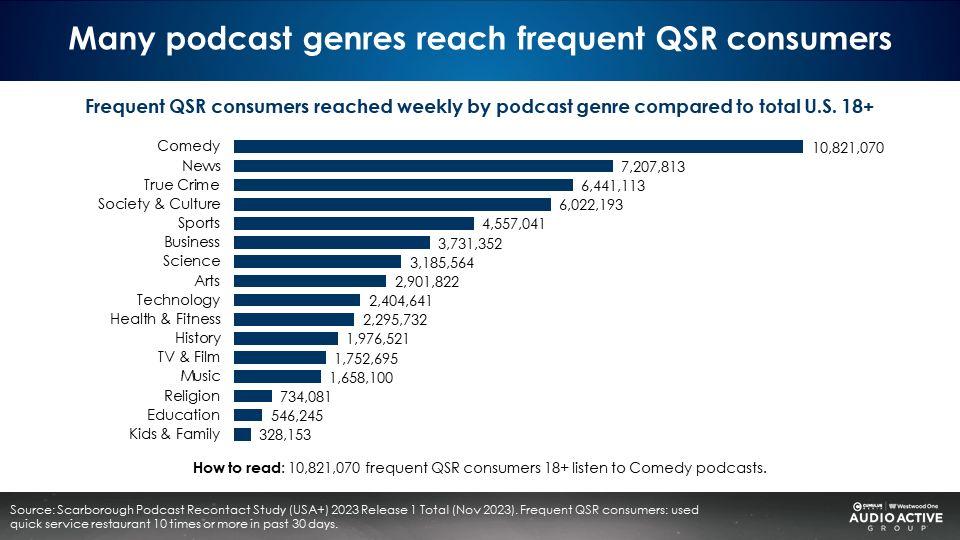
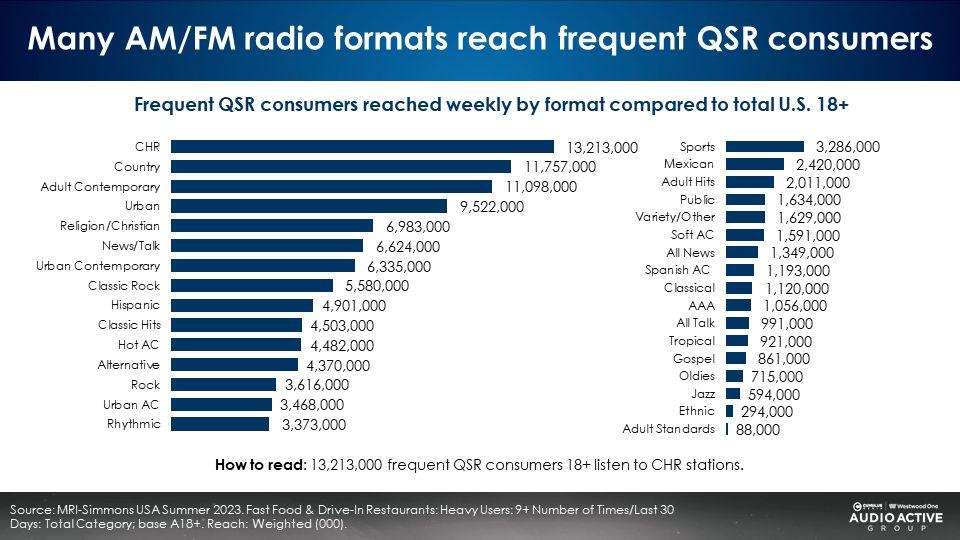
ABX creative testing: QSR AM/FM radio ads test at 89% of the effectiveness of TV at one-fourth the CPM
The old myth is that TV creative is better than AM/FM radio because it has “sight, sound, and motion.” However, eye gaze testing reveals only a minority of viewers have “eyes on glass” when TV ads run.
In fact, the “sound only” audience for TV ads (40%) is just as big as “eyes on glass” viewership (40%). For many, the TV advertising experience is akin to an AM/FM radio ad that is heard while gazing at the cell phone.
ABX, a leader in creative testing, measured 764 QSR TV ads and 85 QSR AM/FM radio ads. Across a series of measures (clear brand, message delivery, reputation, likeability, and taking action), the AM/FM radio ads preformed very similarly to the TV ads at a fraction of the CPM.
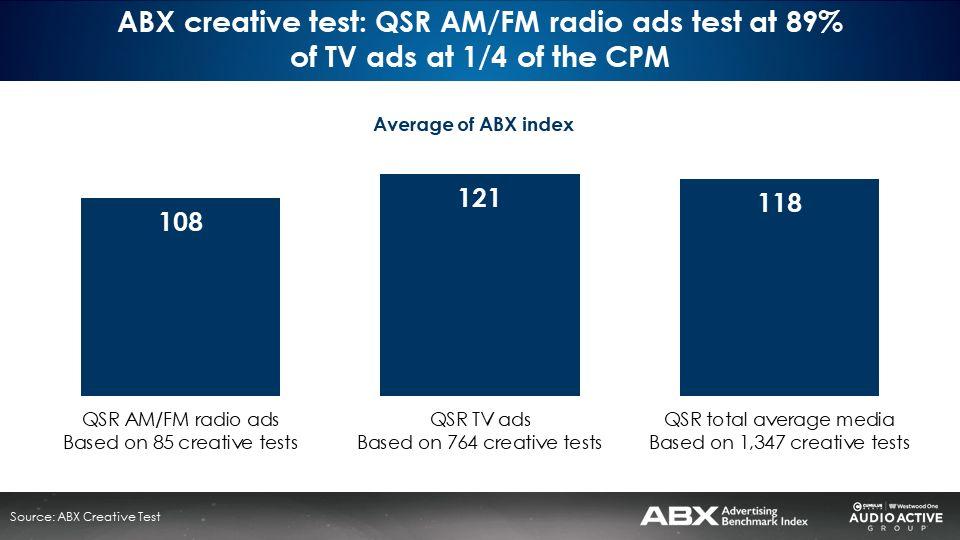
Nielsen sales lift studies reveal AM/FM radio ads generate a +6% increase in total QSR buyers and a $3 to $1 return on investment
Nielsen matched Portable People Meter AM/FM radio commercial exposures to credit and debit card spending. For every dollar of AM/FM radio advertising, $3 dollars of incremental sales were generated.
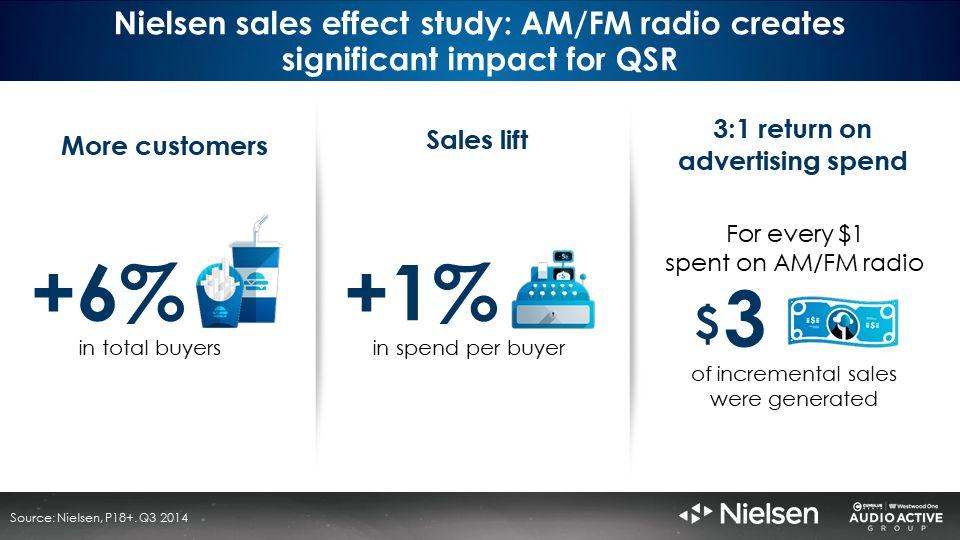
Key takeaways:
- Frequent fast-food consumers are younger, are more likely to be employed, more likely to have kids, and clock a lot of miles in their vehicles
- Heavy AM/FM radio listeners are frequent fast-food diners: Most AM/FM radio ad impressions are generated by heavy QSR category users
- Heavy TV viewers under index on QSR; Most TV impressions are generated by light QSR category users
- There is a mismatch in fast-food advertising media budgets: TV is overused and AM/FM radio is underutilized
- QSR TV deliveries are collapsing: AM/FM radio to the rescue; AM/FM radio makes QSR TV campaigns better by generating significant incremental reach, especially in younger demos
- ABX creative testing: QSR AM/FM radio ads test at 89% of the effectiveness of TV at one-fourth the CPM
- Nielsen sales lift studies reveal AM/FM radio ads generate a +6% increase in total QSR buyers and a $3 to $1 return on investment
Click here to view a 15-minute video of the key findings.
Pierre Bouvard is Chief Insights Officer of the Cumulus Media | Westwood One Audio Active Group®.
Contact the Insights team at CorpMarketing@westwoodone.com.